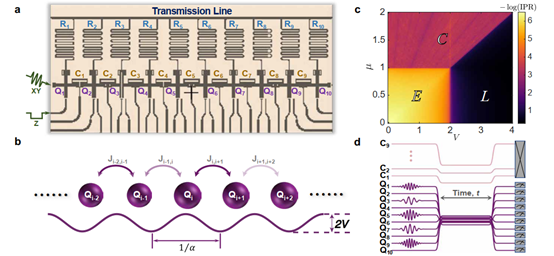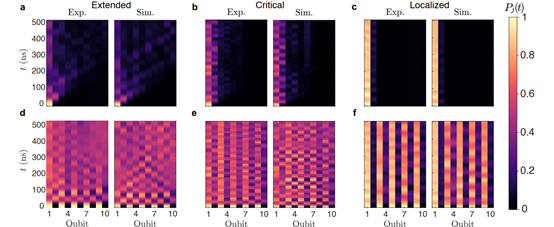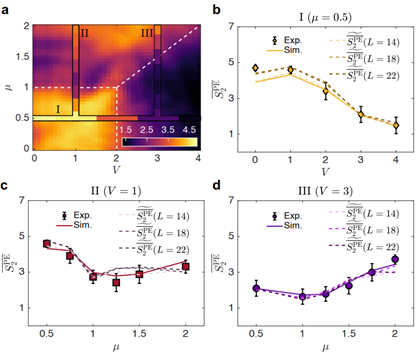Quantum Cloud Group of BAQIS Realized the Critical Phase Transition of the Aubry-André-Harper (GAAH) Model
2023/05/11
Quantum Cloud Group of BAQIS and the Institute of Physics, Chinese Academy of Sciences, used a superconducting quantum chip with 10 bits and 9 couplers arranged in one dimension to realize the promotion of the Aubry-André-Harper (GAAH) model for the first time. The different kinetic properties of the three phases and the phase transitions between them were observed at the multi-particle dynamics level. On April 25, 2023, the research results were published in npj Quantum Information under the title "Observation of critical phase transition in a generalized Aubry-André-Harper model with superconducting circuits".
Quantum simulation provides a powerful tool to study many-body physics, which might be challenging for a classical computer. By manipulating artificial quantum systems, such as superconducting qubits, specific model Hamiltonians can be directly realized by engineering the platform Hamiltonians. The Aubry-André-Harper (AAH) model, as a workhorse for studying localization and topological states, has recently attracted widespread interest in both experimental and theoretical research. A generalized AAH (GAAH) model, which includes both diagonal and off-diagonal quasi-periodic modulations, shows three distinct phases (extended, localized, and critical phases) with different topological and localization properties. However, simulating the Hamiltonian of the GAAH model requires both diagonal and off-diagonal quasi-periodic modulations, which are difficult to realize with traditional architecture of superconducting processor. Moreover, although the GAAH model has been realized in cold atoms systems in momentum space, only single-particle (mean-field) level dynamic behavior has been observed.
Recently, a joint Ph.D. student Hao Li and Ph.D. student Yong-Yi Wang from the Q03 group at the Institute of Physics, Chinese Academy of Sciences/State Key Laboratory of Condensed Matter Physics, under the guidance of Professor Heng Fan and Associate Professor Kai Xu, collaborated with Professor Dongning Zheng from the SC5 group, Deputy Chief Engineer Zhongcheng Xiang from the SC5 group, Associate Professor Xiaohui Song from the Q02 group, and Professor Shu Chen from the T01 group, simulate the GAAH model for the first time on a superconducting qubits with tunable couplers. They observed different dynamic properties of the three phases and the phase transitions between them. The results have been published in npj Quantum Information 9, 40 (2023).
The experiment was carried out on a superconducting processor consisting of a one-dimensional array of 10 qubits and 9 couplers. By precisely controlling the frequencies of the qubits and couplers, quasi-periodic modulations of the qubit frequency and nearest-neighbor hopping strength were achieved to realize the Hamiltonian of the GAAH model and change the system parameters to be in the three different quantum phases, including the extended, localized, and critical phases. The experiment observed spin transport behavior in different phases for single-excitation and multi-excitation states. With the capability of precise simultaneous control and readout, they measured the participation entropy of multi-excitation dynamics, demonstrated the multifractal behavior in the critical phase, and characterized the transitions between the three phases. The tunable coupling architecture of superconducting processors greatly extends the simulation range realms for a wide variety of Hamiltonians, and can be used to study various quantum and topological phenomena.
This work, entitled "Observation of critical phase transition in a generalized Aubry-André-Harper model with superconducting circuits", was recently published. The authors also include Professor Shiping Zhao and Associate Professor Ye Tian from the Q03 group, Professor Zhanying Yang from Northwest University, and other Ph.D. students and postdocs. This work was supported by the National Natural Science Foundation of China, Innovation Program for Quantum Science and Technology, Strategic Priority Research Program of Chinese Academy of Sciences, Beijing Natural Science Foundation, Scientific Instrument Developing Project of Chinese Academy of Sciences, the Key-Area Research and Development Program of Guang-Dong Province and the State Key Development Program for Basic Research of China.

FIG. 1. Schematic diagram of the superconducting processor and the GAAH model

FIG. 2. Spin transport.

FIG. 3. Time evolution of participation entropy.

FIG. 4. Averaged late-time participation entropy.
 中文
中文 Email
Email QCloud
QCloud Log in
Log in
